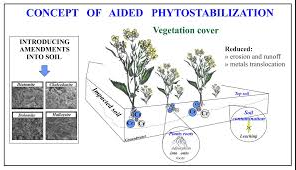Phytoremediation of inorganic pollutants
Contaminated
soil treatment
Inorganic pollutants detoxification is carried out by the following procedures mention below;
§Phyto-remediation (plants
used)
§Bio-remediation(microbes
used)
Sources of heavy metals in environment
There are different sources of heavy metals like atmospheric deposition, mining activities and the role of different industries.
Sources of heavy metals in environment
Inorganic Pollutants
Following are the different inorganic pollutants mentioned below;
- Arsenic
- Chromium
- Uranium
- Mercury
- Selenium
- Cadmium
- Copper
- Lead
Phytoremediation
Use of green plants for removal of inorganic pollutants
from contaminated site.
Accumulation of pollutants in plant tissues by roots.
Accumulation of pollutants in plant tissues by roots.
Advantages
- The cost of phyto-remediation is lower.
- Recovery and reuse of valueable metals.
- Minimal land disturbance.
- Reduce transport of contaminants by wind and reduce soil erosion.
- Multiple contaminants can be remove within the same plants.
Phyto-remediation Mechanism
Phyto-extraction
It is removal of inorganic pollutants from soil solution and their storage in plant (non-toxic
form).
• Fern stores Arsenic
• Sunflower
remove uranium
Phytoextraction
Phytostabilization
Refers to immobilization of
inorganic pollutants in soil by roots through
•Absorption
•Precipitation
•Not added to food
chain (because it prevent downward movement)
Phytotransformation
Pollutants is taken up by the plants and transformed in plant tissues (To be effective must be transformed to a less toxic form).
It
is the ability of plants to change the molecular
composition of certain inorganic pollutants.
1.Metabolic processes within plants.
2.Effects of compounds such as enzymes.
Phytostimulation
•Microbes
in rhizosphere transform inorganic
pollutants to non toxic products.
Phytovolatilization
Plants remove contaminants in volatile forms and
transpiring them into atmosphere.
§Work
on heavy metal (mercury)
Conclusion
§The
main factor driving
the implementation of phytoremediation project are
1. Stabilization
2. remediation of many
contaminated sites.
Inorganic pollutants detoxification is carried out by the following procedures mention below;
§Phyto-remediation (plants
used)
§Bio-remediation(microbes
used)
Sources of heavy metals in environment
There are different sources of heavy metals like atmospheric deposition, mining activities and the role of different industries.
Sources of heavy metals in environment
Inorganic Pollutants
Following are the different inorganic pollutants mentioned below;
- Arsenic
- Chromium
- Uranium
- Mercury
- Selenium
- Cadmium
- Copper
- Lead
Phytoremediation
Use of green plants for removal of inorganic pollutants
from contaminated site.
Accumulation of pollutants in plant tissues by roots.
Accumulation of pollutants in plant tissues by roots.
Advantages
- The cost of phyto-remediation is lower.
- Recovery and reuse of valueable metals.
- Minimal land disturbance.
- Reduce transport of contaminants by wind and reduce soil erosion.
- Multiple contaminants can be remove within the same plants.
Phyto-remediation Mechanism
Phyto-extraction
It is removal of inorganic pollutants from soil solution and their storage in plant (non-toxic
form).
• Fern stores Arsenic
• Sunflower
remove uranium
Phytoextraction
Phytostabilization
Refers to immobilization of
inorganic pollutants in soil by roots through
•Absorption
•Precipitation
•Not added to food
chain (because it prevent downward movement)
Phytotransformation
Pollutants is taken up by the plants and transformed in plant tissues (To be effective must be transformed to a less toxic form).
It
is the ability of plants to change the molecular
composition of certain inorganic pollutants.
1.Metabolic processes within plants.
2.Effects of compounds such as enzymes.
Phytostimulation
•Microbes
in rhizosphere transform inorganic
pollutants to non toxic products.
Phytovolatilization
Plants remove contaminants in volatile forms and
transpiring them into atmosphere.
§Work
on heavy metal (mercury)
Conclusion
§The
main factor driving
the implementation of phytoremediation project are
1. Stabilization
2. remediation of many
contaminated sites.










Comments
Post a Comment